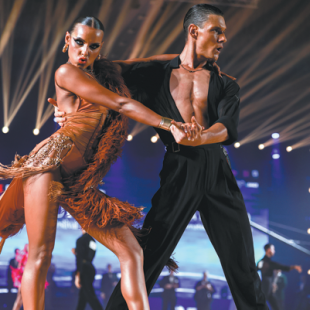Born to burn the floor

When the strains of a waltz first drifted into China in the 1980s, few could have imagined the quiet revolution that was about to unfold. In ballrooms and dance halls from Guangzhou, Guangdong province, to Beijing, a new rhythm began to pulse — one that carried with it not just steps and turns, but an entire cultural dialogue between the East and West.
For Wen Liangfu, a young tour guide in Guangdong at the time, this rhythm would soon chart the course of his life. He remembers that first encounter vividly — a chance glimpse of a performance that struck him with its poise and vitality.
"It was so dynamic, yet full of discipline," he recalls, describing how the dance physically embodied the "gentlemanly elegance" of his imagination.
In 1986, the establishment of the China Ballroom Dance Federation formally introduced ballroom dance to the country. Over the next four decades, the European partner dance form would not only take root but flourish on Chinese soil, evolving into a competitive ecosystem that has produced world-class champions and inspired countless enthusiasts. And among those champions stands Wen — both a witness to and a driving force behind this transformation.
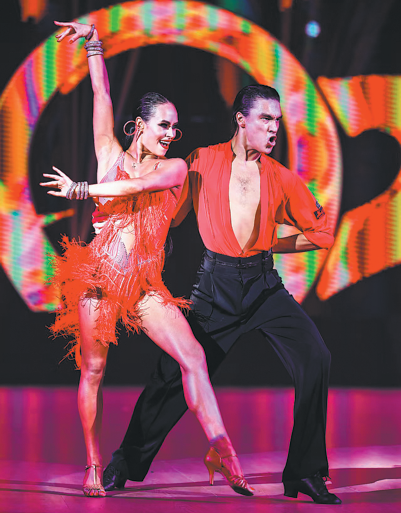
With China's reform and opening-up policy ushering in an era of cultural exchange, Guangdong became one of the first regions to embrace ballroom dance through its proximity to Hong Kong. Wen, whose job as a tour guide often brought him into contact with foreign visitors, found himself increasingly intrigued.
Through conversations with guests, he learned that the dance style encompassed ballroom (or standard or modern ballroom) and Latin dancing, featuring elegant, sweeping movements in dances like the waltz and quickstep.
"If I could learn the dances," he remembers thinking, "I'd have more to talk about with my guests."
When he spotted a newspaper advertisement for a local ballroom troupe recruiting students, Wen immediately signed up. His enthusiasm, coupled with a natural sense of rhythm and expression, set him apart from the start.
Many of the foreign tourists Wen guided were themselves ballroom enthusiasts, and several became informal mentors, sharing tips and materials. One German visitor, impressed by Wen's dedication, mailed him instructional videotapes after returning home — a precious resource in the pre-internet era.
"Those videos really shortened my learning curve," Wen says, adding that he also took private lessons from veteran dancers from Hong Kong.
In May 1987, Wen traveled to Beijing to compete in China's first-ever national ballroom dance contest, where he secured fifth place in the amateur division.
Encouraged, he threw himself fully into training, determined to elevate his craft. Over the following decade, Wen's name became synonymous with excellence in both modern and Latin categories at national championships and major Asian events.
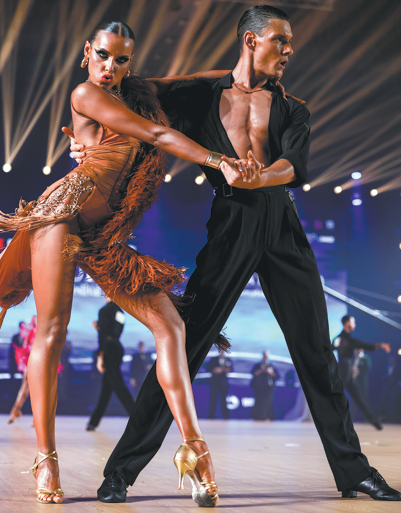
In both 1999 and 2000, Wen, together with his partner and wife Sun Rong, won the gold prize of the prestigious Lotus Award, China's highest dance award.
In 2004, following his retirement from professional competition, Wen transitioned from the competitive dance floor to the classroom.
He cultivated a new generation of talent through teaching positions at prestigious institutions like the Shanghai Film Academy and Beijing Dance Academy, while also lending his expertise to the planning and direction of national competitions.
In 2014, he coauthored the technical manual Techniques of Ballroom and Latin American Dancing with Sun. Today, Wen, president of the Guangdong Dance Sport Council, has been extending his influence to a bigger stage as the lead organizer of the annual World Cup Universal Open Dance Festival in Shenzhen, Guangdong.
The festival's seventh edition, which concluded recently, brought together elite dancers from nearly 40 countries for a week of competitions, master classes and gala balls.
"I hope to build a platform where more talented individuals can shine. That includes both skilled adjudicators and dancers," Wen says.
To achieve this, the weeklong festival is structured with care — offering divisions for the professionals in the high-level competition of the Professional Ballroom World Championship, amateurs, and even young beginners.
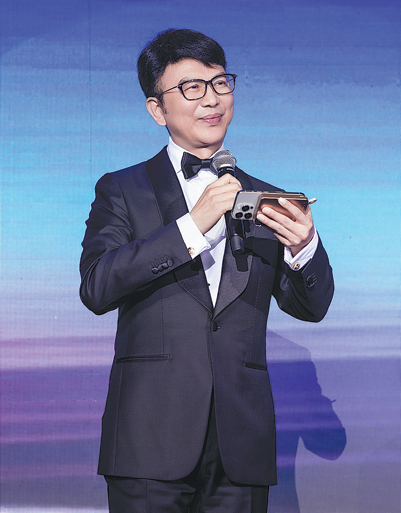
"Our participants cover a wide age spectrum," he explains.
"We aim to encourage everyone to learn to dance and improve their physical fitness through more categories and a broader award system."
Dance, he adds, has been transformative for him personally. It has kept him physically fit and mentally sharp, while also cultivating a more open and inclusive outlook.
This year's festival drew around 60 international adjudicators, among them seasoned professionals like Australian dancer and judge Donna Shingler who talks of her long-standing connection to the event.
"We have come to Shenzhen many times to support Wen, and we love this event."
She explains that this opportunity brings all the competitors together and features a "very, very high-level panel of adjudicators". This, she concludes, gives the couples a clear and valuable measure of both their current dancing level and their future potential.
Among the judges was also Lithuanian ballroom dancer Arunas Bizokas, an 11-time champion of the WDC (World Dance Council) World Professional Ballroom Championship in standard ballroom and now the president of the World Dance Organization.
His connection with Wen dates back more than two decades, to when he was first invited by Wen and Sun to perform in China.
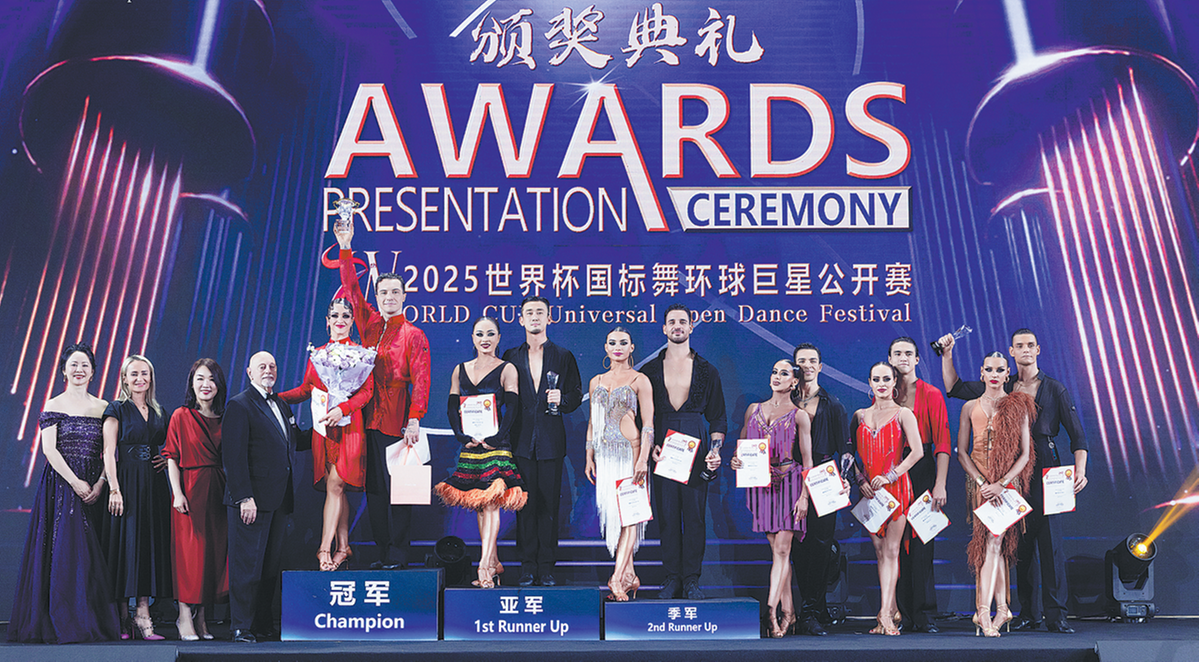
"I've seen a rapid growth in the level of dancing in China and the number of high-level competitors. That is very impressive," notes Bizokas.
"China is now among the leading countries in the dancing world with the top couples."
He praises the Shenzhen festival for its professional facilities — from stage lighting and sound design to the quality of the flooring. He notes that such high-standard conditions are not only appreciated by the dancers for their comfort and beauty but also contribute to enhanced performance levels.
Since stepping away from competitive dancing, Bizokas has focused on mentoring and promoting equity in global dance sport through the WDO in its mission to foster greater equality of opportunity for dancers worldwide.
"We realized that our primary focus must be on providing the right conditions for dancers at high-level events like this," he says, referring to the dance festival in Shenzhen.
He went on to elaborate that these essential conditions encompass the quality of adjudicators, facilities, accommodation and competitor rewards, including prize money.
"All of those things are very important. And I see that it is developing in the right direction right now."
Contact the writer at xingwen@chinadaily.com.cn


